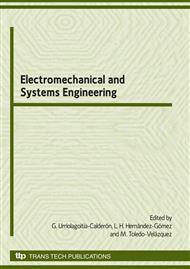[1]
H. Slocum. Precision machine design. Prentice Hall, EUA, (1992).
Google Scholar
[2]
R L. Williams II and A R. Joshi. Planar parallel 3RPR manipulator. Proceedings of the Sixth Conference on Applied Mechanisms and Robotics, (1999).
Google Scholar
[3]
G. Yang W. Chen and I. Chen. A geometrical method for the singularity analysis of 3RRR planar parallel robot with different actuation schemes. Proceedings of the 2002 IEEE/RSJ International Conference on Intelligent Robots and Systems, EPFL, Lausanne, Switzerland, (2002).
DOI: 10.1109/irds.2002.1041568
Google Scholar
[4]
I. E Uphoff, Introducing parallel manipulators through laboratory experiments. IEEE Robotics & Automation Magazine, (2003).
DOI: 10.1109/mra.2003.1233552
Google Scholar
[5]
G. Liu, Y. Lou and Z. Li. Singularities of parallel manipulators: A geometrical treatment. Transactions on Robotics and Automation, Vol. XIX, (2003).
Google Scholar
[6]
J. Yoon, J. Park and J. Ryu. Walking control of a dual-planar parallel robot for omni-directional locomotion interface. (2004).
DOI: 10.1109/iros.2005.1545561
Google Scholar
[7]
J. Yoon and J. Ryu. The development of the 3-DOF planar parallel robot (RRR Type) for omnidirectional locomotion interfaces. 3 rd IFAC Symposium on Mechatronic Systems, Sept. 6-8, Sydney Australia, (2004).
DOI: 10.1016/s1474-6670(17)31082-0
Google Scholar
[8]
E. Castillo, J. Fonseca and C. Lopez. Non-linear control to compensate low velocity friction of a planar parallel robot. Proceedings of 12th World Congress in Mechanism and Machine Science, IFTOMM 2007, June 17-21, Besancon France, (2007).
Google Scholar
[9]
S. Briot and I. Bonev. Are parallel robots more accurate than serial robots? Transactions of the Canadian Society for Mechanical Engineering. Vol. 31, No. 4, pp.445-4, (2007).
DOI: 10.1139/tcsme-2007-0032
Google Scholar
[10]
P. Geradin and M. Duysinx. An introduction to robotics: Mechanical aspects. University of Liège. (2004).
Google Scholar
[11]
S. Briot and I. Bonev. Accuracy analysis of 3dof planar parallel robots. Mechanism and Machine Theory, Vol. 43, No. 4, pp.445-458, (2008).
DOI: 10.1016/j.mechmachtheory.2007.04.002
Google Scholar
[12]
L. W. Tsai. Robot Analysis, The mechanics of serial and parallel manipulators. Wiley Interscience. EUA (1999).
Google Scholar
[13]
R. Yañez, M. Ruiz and E. Morales. Diseño conceptual de una mesa de trabajo XY-THETA basado en un mecanismo paralelo planar. 10° Congreso Nacional de Ingeniería Electromecánica y de Sistemas - IPN, Noviembre 26-30, México D. F. (2007).
DOI: 10.5944/bicim2022.050
Google Scholar


